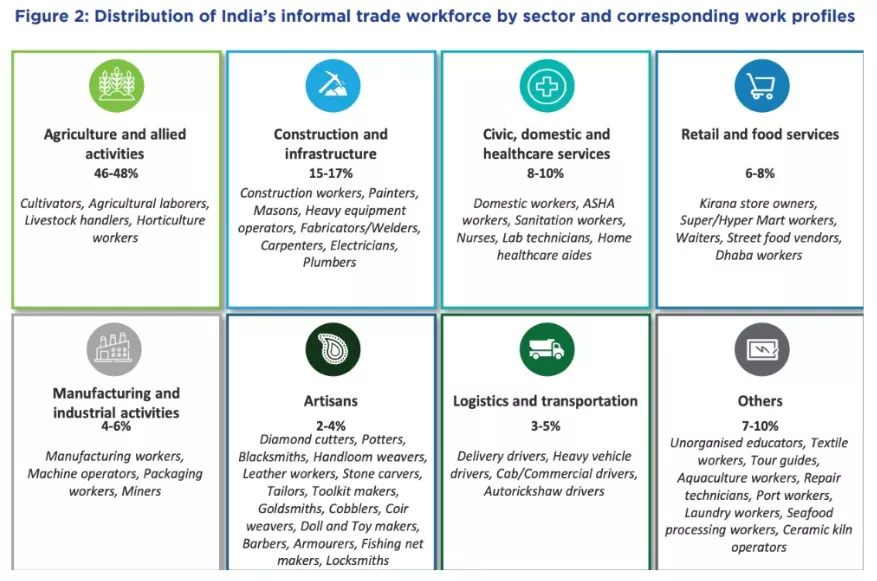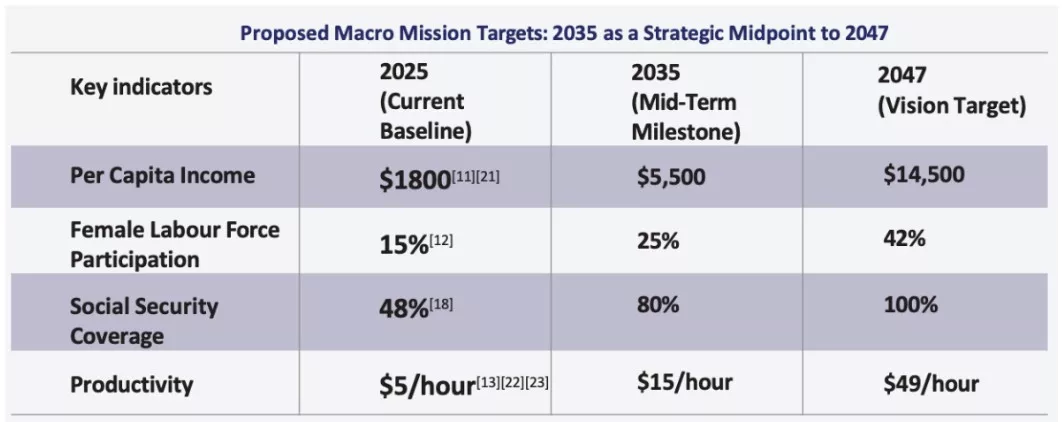NITI Aayog has released the report “Roadmap on AI for Inclusive Societal Development”, mapping how Artificial Intelligence (AI) and frontier technologies can uplift India’s 490 million informal workers through digital inclusion, skilling, and social security integration.
Current State of Informal Workers in India
- Largest employment generator: Nearly 490 million Indians (≈90% of total workforce) are engaged in informal work and contributing 45% to India’s GDP.
 Dominance in Rural Economy: Over 80% of rural workers lack formal contracts or social security, heavily concentrated in sectors like construction, retail, and handicrafts.
Dominance in Rural Economy: Over 80% of rural workers lack formal contracts or social security, heavily concentrated in sectors like construction, retail, and handicrafts.- Low Productivity and Wages: Average productivity in the informal sector is one-fourth of the formal sector, translating to approximately $5 per hour (half the national average).
- Gendered Informality: According to the IMF, 60% of all workers are involved in unregulated jobs, heavily present in home-based and agricultural work, with lower wage parity .
- Social Security Gap: Only 48% of informal workers are covered by any form of social protection; majority depend on daily or piece-rate income.
Challenges Faced by the Informal Trade Workforce
Thematic Challenges
NITI Aayog’s persona-based research distilled five recurring and cross-cutting themes that constrain informal workers’ growth and inclusion
- Financial Fragility & Volatility: Chronic income instability stems from irregular wages, lack of contracts, and dependence on informal credit.
- Workers often face payment delays and disputes due to absence of verifiable identities.
- For example: Over 75% of informal workers earn below ₹10,000/month and lack access to affordable credit or insurance (Periodic Labour Force Survey, 2024).
- Market Access & Demand Linkages: Most workers operate on the margins of the market, with limited access to steady demand, digital platforms, or secure contracts.
- Migrant workers especially suffer from non-portable IDs and exploitative intermediaries.
- Skilling & Adoption: Skilling systems are fragmented and outdated, with limited access to localized digital learning tools.
- Many depend on traditional methods that are not adaptive to modern work demands or devices.
- Social Protection & Occupational Safety: The informal sector remains outside institutional safety nets, making workers highly vulnerable to shocks.
- Occupational hazards, absence of safety standards, and lack of protective technologies are rampant.
- Productivity Gaps: Workers face low output not because of effort, but due to manual workflows, lack of digital tools, and no access to credit.
- Absence of mechanization and workflow optimization leads to high effort, low returns, and invisibility of performance.
Systemic Barriers
Beyond individual challenges, the report identifies four systemic barriers that perpetuate informality and inequality
- Trust Deficit: Absence of verifiable identities, contracts, and work histories undermines employer–worker trust and access to secure employment or finance.
- Systemic Access & Usability Gaps: Digital illiteracy, language barriers, and complex interfaces restrict workers from accessing formal services or marketplaces.
- Knowledge & Capability Gaps: Inadequate skilling ecosystems and missing worker data constrain adaptability and targeted policy support.
- Structural Inefficiencies & Tooling Deficit: Dependence on manual labour, poor access to modern tools, and fragmented digital systems reduce efficiency and increase vulnerability.
High Cost of Delay: Why India Must Act Now
India stands at a critical juncture. Despite a strong digital backbone (Aadhaar, UPI, BharatNet), delayed action could widen inequality.
- Economic Urgency: At the current 6.3% growth rate, India’s GDP will reach US $15.3 trillion by 2047 which is well below the US $30 trillion Viksit Bharat target.
- For informal workers, this means their average annual income will stagnate at US $6,000, far below the US $14,500 threshold required for India to achieve high-income status.
- Risk of Exclusion: Delay risks excluding millions from the digital economy, leaving them unskilled and underpaid in a technology-driven world.
|
Potential of AI for the Informal Sector
- AI as a Force for Inclusion: Under the #AIforAll framework, AI is positioned not as a disruptor but as a driver of equitable growth.
- By embedding intelligent systems across labour markets, financial services, healthcare, skilling, and social protection, India can integrate informal workers into the mainstream of the digital economy
- Social Inclusion
Potential of Frontier Technologies
By 2035, India aims to lead in scaling inclusive technology solutions that serve the informal sector.
- Artificial Intelligence (AI): Enables credit scoring, predictive analytics, and personalized skilling paths.
- Internet of Things (IoT): Improves workplace safety and operational efficiency.
- Blockchain: Ensures secure and transparent smart contracts and payments.
- Robotics: Enhances efficiency and safety in construction and manufacturing.
- Immersive Learning: Offers adaptive, vernacular-based training for diverse skill sets.
|
-
-
- Vernacular AI models (via Bhashini and AI4Bharat) can make digital services accessible to non-English speakers.
- AI can promote gender inclusion raising women’s workforce participation from 15% (2025) to 42% (2047)
- Economic Empowerment: AI can raise productivity from $5/hour to $49/hour by 2047, as projected in the roadmap.
- Improved job-matching and credit access will stabilize incomes and drive upward mobility.
- Market Access and Productivity: Small artisans and farmers can leverage AI-driven e-commerce recommendation systems or precision agriculture tools to connect directly with buyers and reduce dependence on intermediaries, thus raising incomes.Access to Finance and Social Security: AI-based credit scoring models, using alternative data such as mobile transactions or work history, can enable micro-credit and insurance opportunities for those without formal financial records.
- Enhancing Trust and Efficiency: AI-powered digital identities and smart contracts can ensure timely payments and verifiable employment histories.
- Blockchain-enabled systems can reduce dependence on intermediaries and enhance transparency in transactions.
- Personalized Skilling and Upskilling: AI-powered mobile learning platforms can help informal workers acquire new, context-specific skills.
- For example: AI-driven translation tools can deliver training in regional languages, helping a carpenter or weaver learn design tools or safety methods in their mother tongue.
- Healthcare and Well-being: AI-enabled telemedicine platforms can bridge access gaps for workers in rural or peri-urban areas, offering diagnostics and personalized health monitoring at low cost.
- Data-Driven Governance: AI can help policymakers analyze real-time worker data, identify gaps in social protection, and target welfare delivery effectively.
- AI for Safety and Social Security: Predictive analytics and IoT-enabled monitoring can anticipate workplace risks, trigger insurance claims, and ensure occupational safety compliance.
- For Example: AI-enabled risk monitoring could reduce workplace accidents, which currently cause hundreds of preventable fatalities annually in informal sectors
Actionable Recommendations for Success
- Digital Empowerment and Access: Build a nationwide digital ecosystem where AI, IoT, and blockchain-based platforms enable workers to access skilling, jobs, and welfare in their own language and region.
- Establish AI-enabled Common Service Centres (CSCs) and district-level digital hubs to ensure last-mile digital access, especially for rural and migrant workers
- Integrate all worker databases (e-Shram, UDYAM, DigiLocker) through a Federated Digital Identity System, ensuring verifiable work credentials and portability across states.
- Financial Inclusion and Trust Infrastructure: Deploy AI-based credit scoring models using alternative data—UPI transactions, job history, and social security records—to help workers access formal micro-credit and insurance.
- Use blockchain smart contracts to ensure transparent and timely wage payments in sectors like construction, gig work, and handicrafts.
- Build AI-powered grievance redressal and payment verification systems to enhance trust between workers and employers.
- Adaptive Skilling and Lifelong Learning: Launch AI-driven vernacular learning platforms to deliver personalized, on-demand skilling aligned with market needs.
- Employ immersive learning (AR/VR) for safety training and hands-on technical education in trades such as plumbing, carpentry, and healthcare assistance.
- Partner with industries to continuously update curricula based on AI-predicted labour demand trends.
- Social Protection and Safety through Technology: Leverage IoT and predictive analytics to monitor workplace safety and prevent occupational accidents—particularly in high-risk sectors such as mining, construction, and textiles.
- Link AI-driven safety alerts to automatic insurance disbursement and health benefits, ensuring that social protection is proactive rather than reactive.
- Strengthen real-time monitoring systems for welfare schemes to track coverage and delivery at the local level.
- Governance and Policy Ecosystem: Develop a National AI for Labour Observatory under NITI Aayog to collect, analyze, and forecast trends in informal employment, wages, and skills.
- Promote ethical and responsible AI adoption through data protection, algorithmic transparency, and fairness safeguards under the Digital Personal Data Protection (DPDP) Act, 2023.
- Incentivize innovation by offering grants, tax benefits, and R&D credits to startups and social enterprises building affordable AI tools for the informal economy.
Mission Digital ShramSetu
To operationalize this vision, NITI Aayog proposes the Digital ShramSetu Mission, a national initiative to bridge the technological divide across the informal sector.
The mission emphasizes:
- Persona and sector-led prioritization to cater to diverse worker categories.
- State-driven implementation ensures contextual, bottom-up deployment.
- Regulatory enablement for innovation, data protection, and ethical use of AI.
- Strategic partnerships between government, industry, academia, and civil society.
- Robust impact evaluation frameworks to monitor inclusivity and real-world outcomes.

Aim: The proposed mission seeks to harness AI and frontier technologies to provide real-time access to jobs, markets, and entitlements, smart contracts linked to verified work outcomes, and modular, demand-driven skilling platforms. |
Conclusion
AI’s success in India will ultimately be measured not by the number of white-collar tasks automated, but by the lives it uplifts in the informal economy. The AI for Inclusive Societal Development roadmap positions India at the frontier of human-centric technology, where every informal worker is visible, valued, and empowered.
![]() 10 Oct 2025
10 Oct 2025

 Dominance in Rural Economy: Over 80% of rural workers lack formal contracts or social security, heavily concentrated in sectors like construction, retail, and handicrafts.
Dominance in Rural Economy: Over 80% of rural workers lack formal contracts or social security, heavily concentrated in sectors like construction, retail, and handicrafts.
